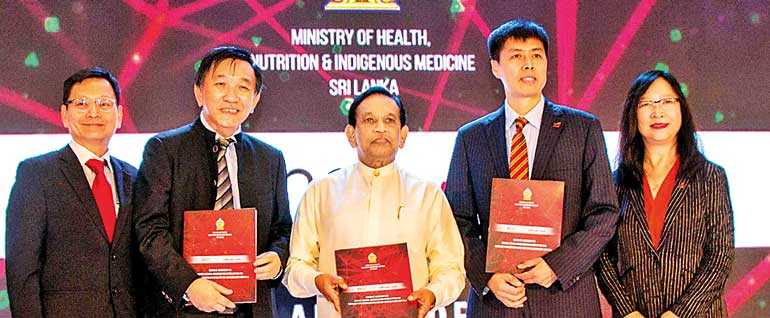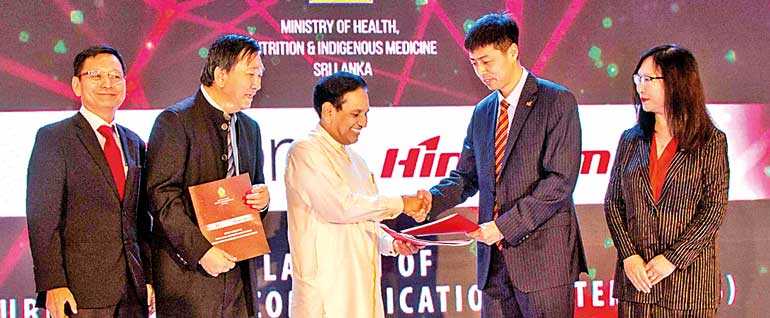Sunday Dec 14, 2025
Sunday Dec 14, 2025
Monday, 14 October 2019 00:00 - - {{hitsCtrl.values.hits}}


Enabling the Government of Sri Lanka’s (GOSL) vision of revolutionising healthcare technology in the country, the Ministry of Health is partnering with the global experts REDtone MEX Sdn Bhd – a subsidiary of Berjaya Corporation, Malaysia and Hinacom Software and Technology, China, an industry leader in medical imaging and telemedicine, to introduce cutting edge, Artificial Intelligence based technology to 20 main Government hospitals islandwide.
This landmark project which costs more approximately Rs. 5.9 billion is spearheaded by the Minister of Health, Nutrition and Indigenous Medicine Dr. Rajitha Senaratne and supported by the Additional Secretary (Development) Janaka Chandraguptha, and Secretary Wasantha Perera. It makes a mark in the history of medical imaging in Sri Lanka by bringing the vast benefits of teleradiology to the public health sector.
In the first phase of this revolutionary project, this partnership of global and local experts will establish a Teleradiology Command Centre at the National Hospital of Sri Lanka (NHSL) providing facilities completely free of charge. The Command Centre will be linked to hospitals around Sri Lanka. The local healthcare industry has been coping with various challenges, including medical care delivery turnaround time, rapid changes and adoption of expensive diagnostic technology, large digital storage needs and rising costs.
Utilising the innovative Picture Archiving Communication System (PACS) and Radiology Information System (RIS) digital platforms the Centre will facilitate enhanced medical imaging services, increasing efficiency as well as bringing considerable cost savings to the public health network in Sri Lanka.
PACS/RIS – a digital platform that transforms medical facilities
The Picture Archiving Communication System (PACS) and Radiology Information System (RIS) is a Medical Imaging platform that will enable the digital transformation of medical facilities around the country. This highly effective online platform utilises software and hardware which allows real-time system reporting with lossless images. It also provides economical storage, presentation, retrieval, distribution, and management of medical images. Transmission of electronic images and reports takes place digitally; so, manual filing, retrieving and distribution of film jackets is no longer required. It allows storage and viewing of all types of medical imaging by healthcare organisations both internally and externally. PACS is generally deployed with RIS which provides electronic management of imaging departments – its major function being patient scheduling, resource management, examination performance tracking, reporting, results distribution and procedure billing. Critical for the efficient workflow of radiology practices RIS also complements HIS (Hospital Information Systems) as well as PACS.
Not just a replacement for conventional x-ray methods, PACS offers exceptional return on investments with overall improvement of efficiency and long-term cost savings, as well as countless advantages for medical professionals, which in turn, brings benefits to patients.
Benefits of PACS:
Benefits to medical professionals:
As a paperless or filmless operation, the benefits to the environment, especially in the long term is also a positive factor. The end benefit to patients being access to better medical care at short notice with reduced costs, which can be a life-saver in more ways than one. While medical professionals gain much from PACS-RIS in terms of efficiency and functionality, the advantages also extend to the public health sector and the Government – primarily in terms of cost savings.
Benefits to the MOH:
According to the Director of Medical Supplies Division (MSD) of the MOH, the implementation of this project at 20 public hospitals is expected to save over Rs. 375 million on X-ray films and accessories, and with the introduction of PACS-RIS at relatively low cost, it would enable the MOH to allocate those funds towards improving other facilities.
Bringing first world medical technology to the people of Sri Lanka
Introducing PACS-RIS will bring the concept of digital health to Sri Lanka. This cloud-based Mi (Medical Imaging) Platform is a new age technology that will revolutionise radiology facilities in the country by providing an alternative advanced digital solution that is more efficient, and cost-effective. It will raise the levels of healthcare technology in Sri Lanka to global standards.
Sometimes lives hang in the balance of circumstances when every second counts, every delay and obstacle that stand in the way of medical professionals could literally mean life or death. To those that provide healthcare, such situations are everyday reality. In most developed countries around the world expert consultation and access to critical diagnostic facilities are reachable in an instant through digital technology. Now Sri Lanka too will have the opportunity for access to such vital technology with the ability of sharing instant medical images and data electronically and reporting them remotely thanks to the new initiative to introduce teleradiology facilities.
With an investment of approximately Rs. 5.9 billion, this Government initiative to introduce teleradiology to government hospitals implemented by the global technological strengths of REDtone and Hinacom will pave the way for a better tomorrow, bringing the lifesaving benefits of digital healthcare to millions of people across Sri Lanka.